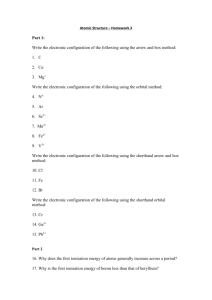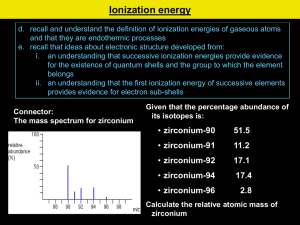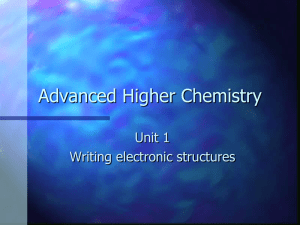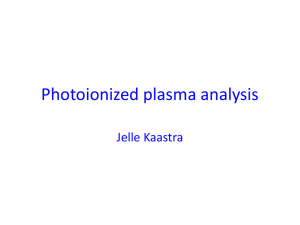9_-_Shells_and_Ionisation_energies
advertisement
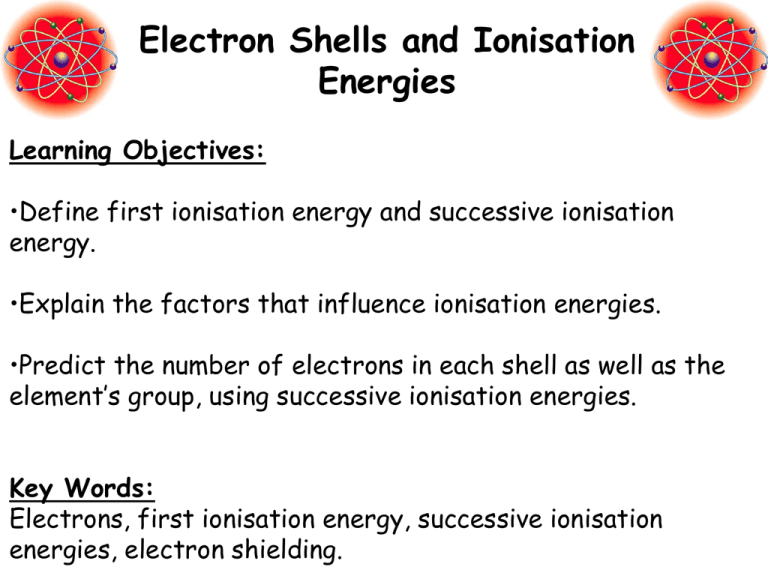
Electron Shells and Ionisation Energies Learning Objectives: •Define first ionisation energy and successive ionisation energy. •Explain the factors that influence ionisation energies. •Predict the number of electrons in each shell as well as the element’s group, using successive ionisation energies. Key Words: Electrons, first ionisation energy, successive ionisation energies, electron shielding. Plasma Displays Plasma TVs have large flat panel displays. The screens consists of hundreds of tiny cells. Each cell holds a mixture of the gasses neon and xenon between two glass plates. The gas is electrically ionised to form a mix of positive ions and negative electrons: Ne(g) Ne+(g) + eXe(g) Xe+(g) + e- This ionisation process requires energy. The mixture of positive ions and negative electrons is called a plasma. The presence of plasma causes the screen to emit light Ionisation Energy The energy needed to form these positive ions is known as the ionisation energy. These energies provide evidence for a model of the atom in which electrons are arranged in shells. The first ionisation energy (1st I.E.) is a measure of how easily an atom looses and electron to form a 1+ ion 1st I.E. = +496 kJ mol-1 Na(g) Na+(g) + e1 mole of gaseous atoms 1 mole of gaseous 1+ ions 1 mole of electrons Successive Ionisation Energies Successive I.E’s are a measure of the energy required to remove each electron in turn. Li(g) Li+(g) + e- 1 Li+(g) Li2+(g) + e- 2 Li2+(g) Li3+(g) + e- 3 st I.E. = +520 kJ mol-1 nd I.E. = +7298 kJ mol-1 rd I.E. = +11815 kJ mol-1 Each successive ionisation energy is greater than the last. Why? Factors Affecting Ionisation Energy Electrons are negatively charged. They are held in orbit in their shells by attraction to the positively charges nucleus. The outermost electrons are furthest away form the nucleus and require the least amount of ionisation energy. The nuclear attraction experienced by an electron depends on three factors. Factors Affecting Ionisation Energy Atomic Radius – The more shells an atom has, and therefore the further the outer electrons are from the nucleus, the less attraction the experience. Nuclear charge – The more protons, the greater the nuclear charge, the greater the attraction felt by the outer electrons. Electron Shielding: Inner shells of electrons repel the outer ones, this is called shielding. The more inner shells there are the larger the effect and the lower the attraction felt by the outer electrons. Successive Ionisation Energies Successive I.E’s are a measure of the energy required to remove each electron in turn. Li(g) Li+(g) + e- 1 Li+(g) Li2+(g) + e- 2 Li2+(g) Li3+(g) + e- 3 st I.E. = +520 kJ mol-1 nd I.E. = +7298 kJ mol-1 rd I.E. = +11815 kJ mol-1 Each successive ionisation energy is greater than the last. Because: • As each electron is removed, there is less repulsion between the electrons and each shell will be drawn slightly closer to the nucleus. • As the distance of each electron from the nucleus decreases slightly, the nuclear attraction increases. More energy is needed to remove each successive electron. Successive Ionisation Energies Questions 1. Write the equation to represent the 4th ionisation energy of chlorine. 2. Sketch a graph you would expect for the successive ionisation energies of Aluminum. 3. An element in period 3 (Na-Ar) has the following successive ionisation energies (in kJ mol-1); 789; 1577; 3232; 4356; 16091; 19785; 23787; 29253 Identify the element and give your reasons. Electron Shells and Orbitals Learning Objectives: •State the number of electrons that can fill the first four shells of an atom. •Define an orbital. •Describe the shapes of s- and p-orbitals. Key Words: Electrons, shell, atomic orbital, energy level, principal quantum number. Energy Levels or Shells We have seen that plotting successive I.E’s provides evidence for: • The presence of shells. • The number of electrons in each shell. Quantum numbers are used to describe the electrons in atoms. • The principal quantum number, n, indicates the shell that the electrons are in. • Different shells have different principal quantum numbers • The larger the value of n, the further the shells is from the nucleus and the higher the energy level. n Shell Electrons 1 1st Shell 2 2 2nd Shell 8 3 3rd Shell 18 4 4th Shell 32 Atomic Orbitals Atomic Orbital: is a region within an atom that can hold up to two electrons, with opposite spins. There are rules governing where electrons are allowed to be within each shell.
